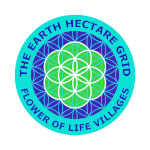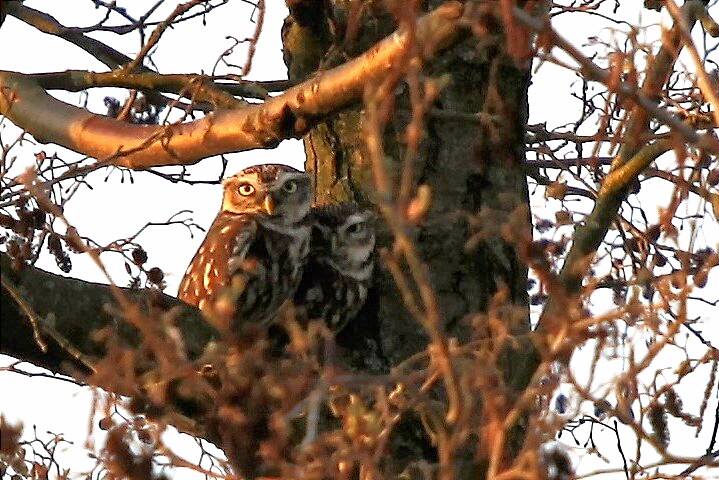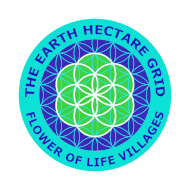
FUNDAMENTAL RIGHTS WILDLIFE
ANIMAL RIGHTS WILDLIFE WORLDWIDEADDITIONS FUNDAMENTAL RIGHTS
Fundamental rights for wild animals largely correspond to those of domesticated animals. That is why you will find a few additions here, geared towards wildlife.
For wild animals, we could also classify their fundamental rights under natural law, as it used to exist when the animals still lived in vast natural areas, without human interference. That was before animals were domesticated, and they were only hunted sporadically by humans, and with respect for the animal.
NATURAL LAW
In this sense, natural law exists without human intervention, and does not depend on time or place. However, when wild animals do not have a healthy habitat, and have lost their territory at the hands of humans, this natural right is out of balance. It causes many animals to suffer unnecessarily, even jeopardizing their evolution.
Thus the idea arose through the development of the Earth Hectare Grid, to create worldwide a renewed territory for the animal kingdom as well.

WILDLIFE DIVERSE CLIMATEZONES
This worldwide renewed territory, might be co-created by all members on the kindomains of hectares villages! For this purpose, a number of guidelines for fundamental rights of wildlife are further explained below.
Most animals presented on this page however, are seen as wildlife in the Netherlands and Western Europe, and there’s a bit of info on ocean life and fishes.
For wildlife in other climate zones, seperate pages might be added. For more information on this, please click on the arrow to the right of the green bar below.
WILDLIFE OTHER CLIMATE ZONES
Do you have stunning pictures of wild life? We would love to place those photographs! The focus is on mammals and birds (both predators and herbivores) and the larger sea creatures.
And are you -or your organisation- able to provide info about wildlife? Such as: What is the climate zone those particular animals are in? And info of the needs of those, such as their preferred habitat and natural food choices. Thus humans worldwide, can anticipate on helping them out. If you think you can help please let us know via the contactform.

NATURAL RIGHTS WILD ANIMALS
THESE ANIMAL RIGHTS ARE BASED ON INSPIRATIONS FROM MARIEKE DE VRIJ, WITH ADDITIONAL GUIDELINES FOR WILDLIFE BY MARGREET OTTO
-1-
NATURE HABITAT
-2-
FOREST AND CONNECTING ROADS
-3-
WATER & FOOD SOURCES
-4-
NATURE SHELTER
-5-
FREE BIRDS
-6-
BEE LIFE
-7-
WATER LIFE

NATURE HABITAT
- 1 -This first category contains information about the natural law of wild animals in their own habitat and territory.
‘The Golden Hour’ – Photo Paul
1 – TERRITORY, HABITAT
At this time, in which we now live, there are still extremely few animals that can live in a free territory, in the measure of one’s own desirability and with the natural food and water supplies, as they once had by nature.
This means that many animal species are aligning themselves in order to live a more ‘restricted’ life. Know less freedom of movement. Less food stocks can be found naturally already. It could even happen that the animals will have less offspring as a result.
It sounds strange, but in a way the animals are going to take their endangered reproduction into account.
ALL OVER OUR ECOSYSTEM
On top of that, as a threatening factor, are the inappropriate side effects of pesticides that are now scattered all over our ecosystem. For example, the potency of the male animals in terms of fertility is decreasing. In addition, pregnant females can also have more miscarriages. It also has dire consequences for smaller animals, including birds, which eat worms and insects that have been sprayed with poison. Unfortunately, there is also containment of several wild animal species (certainly in the Netherlands), and in an unnatural way. Pesticides and other chemicals may therefore not be used in a hectares-village.

FOREST AND CONNECTING ROADS
- 2 -This second guideline includes an explanation of the migration needs and the migration area of wild animals.
2 – FOREST AND CONNECTING ROADS
PROTECTION AND MIGRATION ROOM
The cultivated crops and private domains in a village with hectares are protected from wild animals. The access roads to the center of the village will also be fenced. In order to equally meet the migration needs of wild animals, bridges or viaducts are built near the roads where the animals can walk over or under.
The common roads around the hectares are also suitable as transit routes for both wild animals (except of course for those climate zones where large predators can’t enter), and herded livestock. That is why there is also a speed limit for vehicles, just as we know these type of roads with speed bumps in residential areas.
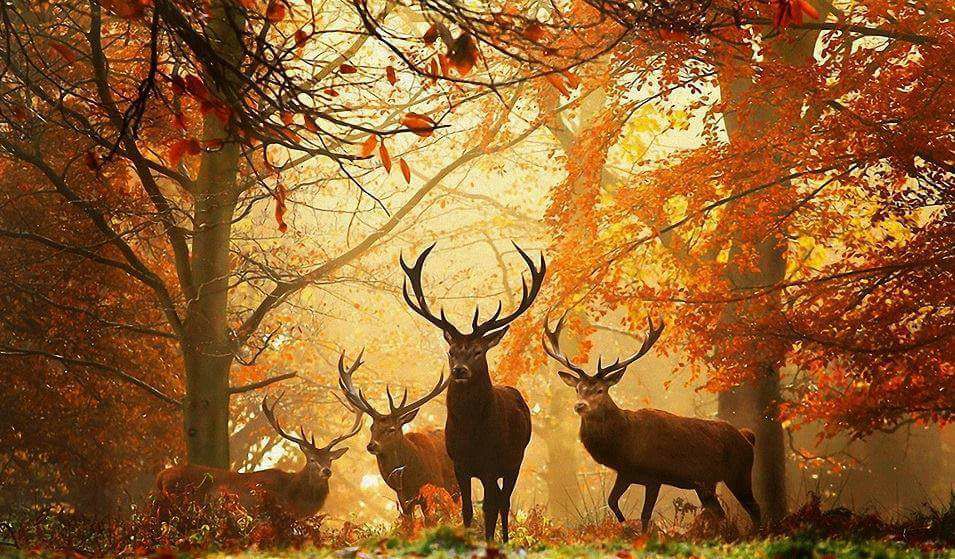
There are also migration routes to other villages, for example over a broadly constructed berm along roads and bicycle paths. Many ornamental grasses can also be planted on these verges, as well as flowers for bees and berry bushes.
DEER AND ROE DEER
A deer (Lat. cervus) is a cloven-hoofed (or like-toed) mammal, and is the male name of the species, we don’t use that word often anymore, but the doe is the female companion. The males wear antlers. There are about 41 breeds of deer, from the large South African antelope to the smaller roe deer, which have shorter antlers (Lat. Capre’olus).
Deer still occur in the Netherlands, but usually they have been released by people in, for example, the dunes (fallow deer), and in a number of forest areas.
There is also a small artificially created landscape in the Dutch IJsselmeer lake. This nature reserve is called the ‘Oostvaarders Plassen’. It has been much discredited, because there was hardly any natural habitat. Hence too little food and shelter for the animals that had been brought there (deer and horses), and they died a slow death of starvation, so that they were eventually shot en masse.
2 - Beyond The Borders
And while we’re on the subject of the Dutch nature reserve ‘Oostvaarders Plassen’, where a lot of deer were shot…
Marieke de Vrij had once worked with people who went hunting. She then described: For instance, if you shoot a deer here, those stimuli will be sent very far through the ether!
The Netherlands as a country is not a large country, but the energetic signals the deers sent, are broadcast far beyond the borders. They can easily enter Germany from the Dutch national park the Veluwe! (This park is in the middle of the Netherlands).
From an energetic point of view, these are very strong incentives. We are used to thinking in radio waves and radio frequencies, and tele-communications, none of which you can hear either. But the inner cries of animals in distress have a very high frequency level that are nevertheless transported through the ether.
Conspecifics are naturally attuned and connected to the frequency level of their own animal species, so that they can hear these inner cries of distress from a great distance.

WATER & FOOD SOURCES
- 3 -This third directive contains information about the natural right to clean natural water and food for wild animals.
3 – WATER- & FOOD SOURCES
Natural food and water supplies, as wild animals once had naturally, have disappeared on a large scale in the Netherlands. That tide can partly be turned by, for example, the construction of special hectare fields in and around hectares-villages.
These are therefore not intended for the establishment of family domains, but as habitats for animals, both domesticated and wild. But what does that look like? For this purpose, such a specific hectare is designated as ‘Hectare-Unit’. This must comply with the blue and green guidelines, as introduced on the homepage, and repeated below.
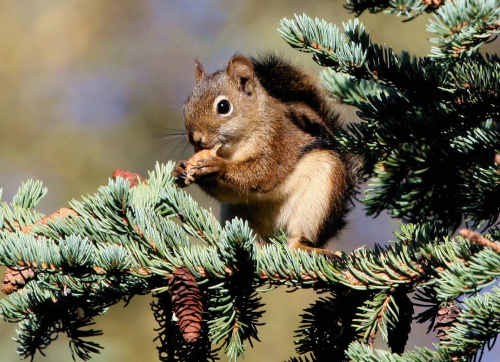
HECTARE UNITS
One Hectare Unit is one hectare of land, intended for the construction of green nature reserves with a lot of biodiversity, which must be suitable as a habitat for domestic and wild animals. A Hectare Unit must comply with the following three guidelines:
1) Each Hectare Unit has a green ‘living’ fence of trees and shrubs. This can be made up of several layers of green. The vegetation is geared in terms of food supply and shelter capacity and nesting capacity to the animal species that traditionally lived on the land concerned.
2) Each Hectare Unit has a quarter hectare of forest. These are preferably trees that feed the animal kingdom. (For example: Acorns, Pine seeds, Walnuts, Beechnuts, and dozens of varieties of berry bushes). The trees should also be suitable for birds to nest in.
3) Each Hectare Unit has a body of water, such as a small lake or pond. These may also be placed against each other at the corners of several adjacent hectares. In such a way a large lake is created. Ideally, the water body is constructed at the lowest point of the hectare of land, or where water is already flowing.
PLANTING VEGETATION FOR ANIMALS
If you choose to allow a nature area or land reserved for it to live on in a more animal-rich way, beyond what was previously thought of, then you have to take this into account with the plantation. And then you have to bring in plants of added value to preserve more animal species on a site that is too small (in proportion to the available land in the Netherlands). That is the last action you can take for the Oostvaarderplassen, for example. There is nothing more. Yes, because the finiteness of life of the released animals there has always taken place naturally, in all age categories of animal species, for varying reasons.
The increase in these kinds of areas of shortened animal life due to human intervention, that is what inspired a number of concerned people to set themselves up for it, and they try to prevent that loss, but they also have no backyard of their own in which to keep the animals! Yeah, you see, so it’s pretty hard. Did you have areas in Europe… there are still areas where, for example, deer are still welcome, but that would require research. There may be areas –very few– but they will also be fewer and fewer.
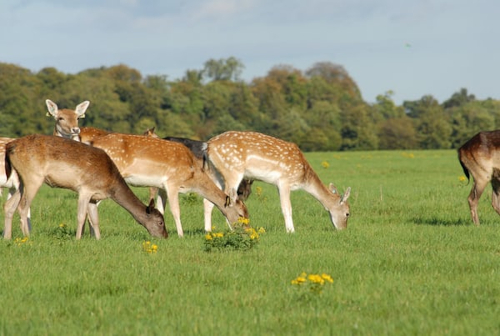
So you have to be knowledgeable about what the animals naturally eat, and where you have areas to add to that. That there is more grass, for example, or more leaf materials, shrubs that can be consumed. But that is also limited and temporary.
For put down a flock of sheep or deer, and in no time they devour all the grassland, all the weeds (benefit), nettles, but also shrubs and newly developed shoots under a tree, or the green foliage of low-hanging branches, and also newly emerged seedlings of trees. This means that the animals have to be extra fed when an area has been grazed bare.
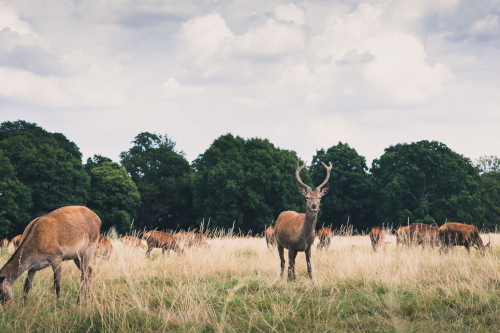
Someone once remarked: ‘In a sense it is a battle between: Do we go for the plants, or do we go for the animals?’
And indeed, the plant world is ‘more generous’ than the animal world, and people in general, are less generous.
There is, however, a sequence. You see that in the whole plant kingdom because it is consumption for all living species. There is, of course, the tendency of people who are completely fascinated by the plant world to conserve rare species. (For example, felling trees for heath formation on the Veluwe, or creating grassland with special shrubs on the Oostvaardersplassen).
But it is important that there is not an illogical death of the animals which is unnecessary. But you could also look up that, how you create the conditions that these plants need, or how they can find them elsewhere, or how they can accommodate those plants elsewhere.
It is mainly the plants that (in the relevant areas) are pulverized by the hooves of (domesticated & wild) animals. The hooves dig out or loosen the plant with the root system, as it were, by walking the animal through the grassland and crops, so that the plant no longer adheres well to the ground. While plants that are overeaten from below, they prepare for a higher growth habit
Look, when it comes to very specific plant species that want to be preserved by humans, and they have no functional value, because they are not consumed but trampled, you could put off pieces of land to preserve the value of that plant. And at the same time you can look for where your plants -if they have developed to a large extent- can be replanted elsewhere. That would be a choice.
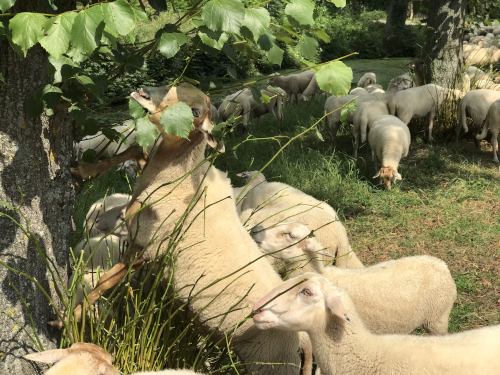
When it comes to the vegetation of shrubs, which are consumed as far as the reach height of the animal using them, and that proves to be insufficient for the wintering, and you want to keep so many animals in a limited area, then you to expand those kinds of crops. Because the plant itself moves higher, and will ultimately choose a growth habit where less damage takes place. Then you need several plants of the same species, with a low growth habit, which therefore does not grow high, and thus raises the leaf type. But the above is not an unequivocal answer. It consists of many variants.
In fact, an area should be large enough for the animals to migrate, so that they can leave behind an eaten plain, which will regrow in a few weeks (except in winter) for the next round of grazing. If such a large area is not available, the animals should now and then be fed a little with food from more distant areas.
Food-bearing trees and shrubs can also be planted. See info at ‘Hectare Units’. Separate policy could also be pursued with regard to green waste from people. For example, if you made pumpkin soup, save and dry the seeds. If you don’t replant it, goats really like it, and it’s nutritious. Also consider vegetable peelings of cabbage leaves, cucumber and so on. Such a win-win system is easy to set up in a hectares-village!

NATURE SHELTER
- 4 -This fourth directive includes an interpretation of the need for shelter for wild animals.
4 – NATURE SHELTER
Too little attention is paid to the fact that also in other habitats on Earth, due to drought, or due to excessive rain, or due to cold, or due to the shifting of borders, because cities advance, or the veins of rivers run dry, that in many places there is more animal life than what the area can physically handle.
That these are radical processes that have been going on here on Earth for thousands of years. That this process, which was started artificially in the beginning, has also reached its limits.
The natural areas in the Netherlands are often too small for large game, and there is little room for migration. Due to the reduced vegetation, there is also too little food available, as well as lack of natural shelter. For example, such as the goats depicted above, resting and grazing in the shade of a few shrubs on a hot summer day.
There are too few shelters and nests for large wild animals, such as deer and boars.
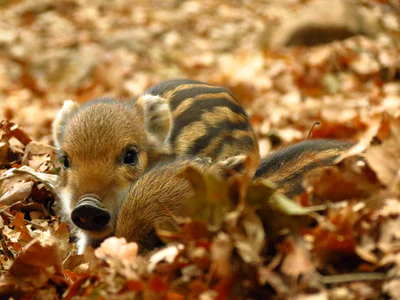
VEGETATION FOR FOOD & SHELTER
It is therefore important to plant vegetation that provides both food and shelter. For the winter, evergreen conifers, such as pine and fir, are suitable. As long as there is no shelter on the hectare units and kindomains, sheds can be placed to protect the animals against rain and wind.
Maybe it’s an idea to make sheds from waste plastic? These can already be pressed into planks, or in the form of a corrugated roof (for rain drainage). Or stackable giant Lego blocks, which are hollow on the inside and can be filled with sand or pebbles to weigh them down, so they can withstand strong gusts of wind.

Ideally, the sheds are made of wood, or blocks of compressed hemp fiber. However, as there has been a lot of logging in the last two decades, and the current agricultural land is still used for intensive livestock farming, these materials are not available.
*******

BIRDS
- 5 -This fifth directive includes an interpretation of the needs of birds.
5 – BIRDS
If you, as a human being, personally wish to develop more into spirituality, in the sense of ‘being deeper attuned to aspects of life that are going on’, then you need animals. Animals help to essentially attune you to matters that lie deeper within yourself.
When people exclude animals, they also exclude something in their memory from that which lives within themselves. Everything that is characteristic of animals is characteristic of man. Memories of what is reflected in animal life are stored in our consciousness.
If you make conscious contact with that, and dare to accept it, it will enlighten your mind.

In every creation there is something unique that can never be found in the same way in others.
Both in animals and in humans a reflection is shown of the sum of ‘being’ quality aspects.
If we do not respect every being that is created as a Divine emissary of its creative energy, we deprive ourselves of the opportunity to learn from the wide variety of Divinity itself.
EXPLANATION
If you think and act separately and experience separateness, you ultimately bring destruction upon yourself, for essentially there is no separation in Creation, only an apparent separation. Animals have something very special and unique, something that lives very deeply hidden in our human subconscious, which requires an answer.
It is not about getting into exactly the same capacity, but about seeing them as a signpost to areas in ourselves that are still unconscious and that we need to become more aware of over time out of spiritual necessity. For example, developing farsightedness, seeing from a distance, like an eagle soaring at a great height.

But also in the so-called simplicity of the sparrow or the ant, there are properties with which we can identify ourselves by looking and feeling through carefully.
They can touch something special in us and thereby develop something in us that you would not immediately think of in the first place.
The animal is not thinking by nature, but purely experiencing. Higher animal species have a very high level of knowing experience, in which what we would call ’thinking’ does not live separately, but falls in unity with feeling. There is no separate thinking active.
The animal encounters itself in relation to man from a continuous Being constitution, and from there it experiences other beings. We try to get into ‘being’ through meditation, animals naturally reside in it.
Man is mainly focused on verbal recognition and support of what he encounters, thereby separating thinking and feeling. In this way he first tries to create a basis for himself, before he comes to acceptance of what surrounds him. He wants to understand before he acts, and thus maintain control.
Western man also sees himself as the highest rung of creation, as a result of which he regards other life forms as lower.
Due to the lack of essential attunement to the other forms of creation around him, he is doing himself a disservice. All character traits of animals are also present in us on a subconscious level, and the animals constantly mirror that to us.
But we categorically deny this fundamental fact, collectively agreeing to the animal abuse and suffering of which we are all aware.
If this is not changed (as already mentioned with the fundamental rights for domestic animals), more and more serious animal diseases will emerge, which will also affect human life itself more and more. (such as germs, pathogens, and ‘zoonoses’ which is an infectious disease caused by a pathogen that has jumped from an animal to a human, e.g. ebola and salmonellosis.)
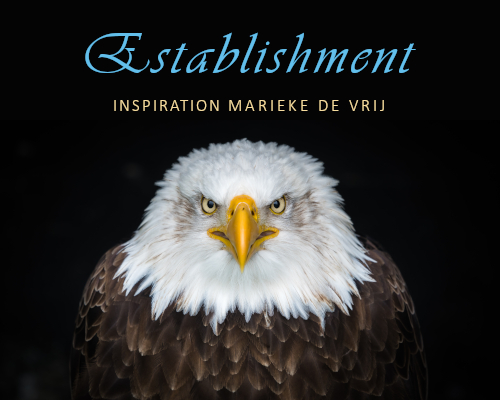
In the case of instruction to man from natural beings, including animals, man is involved in that which has been laid down alive around him.
However, when man -symbolically speaking- ‘holds the scales before his eyes’, and wants to consciously continue to characterize himself from predominance, then Creation can’t be shared with him in a way of self-evidence.
He is surrounded by Divinely illuminated beings, whom he himself doesn’t dare to accept on the basis of a lack of recognition of God’s awareness in himself.
To the detriment of man, it must therefore be stated, that if he doesn’t raise himself up in giving towards the animal kingdom, on the basis of an open frame of mind, he will always experience a shortage in himself.

BEES
- 6 -This fifth guideline contains information about the nature and importance of bees.
6 – BEES
Although bees do not belong to the animal kingdom, but to insect species, we place the information about bees in this category for the time being. That is until there is (possibly) a more extensive ordering. We might see what is going on with the bees right now as one of the many disturbing signs of the times.
Most of us know that bee populations have declined. This is partly due to the use of chemical agents in agriculture and by private individuals. Many also claim that it is because of 5G radiation and other wireless connections that bees are very sensitive to. Therefore, we pay more attention to this, and less known aspects of the bee colonies are also discussed.
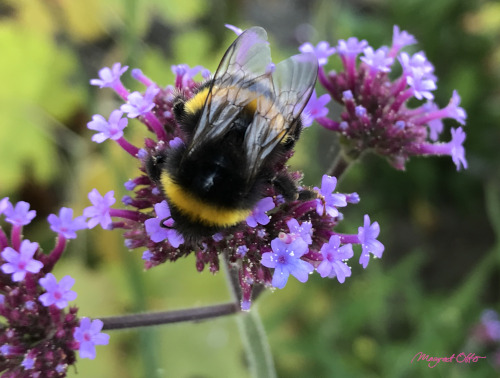
Bumblebees also suffer from radiation
INDEPENDENT FIELD
A bee population has a very independent field of experience in coördination with each other, with the intention of preserving the group atmosphere, and limiting the urge to act to what really matters.
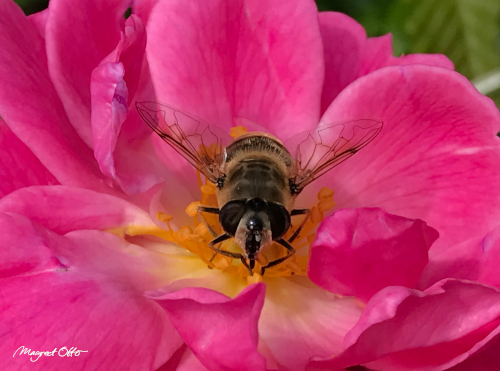
ANTENNA SYSTEM
Bees are an insect species that can quickly suffer from exhaustion, with a highly sensitive antenna system, a sensitive system with which they are quickly subject to restrictions.
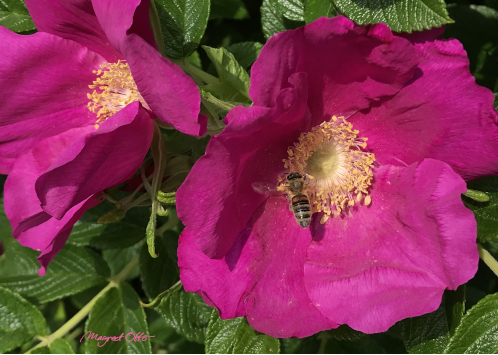
This means that they are closely attuned to each other, but from an essentially independent slant within each bee, each individual bee, in relation to each other.
THE ‘I’ AND THE ‘WE’
So you can say they have a natural ‘I’ sense, but in a huge connection with the ‘we’. And the limitations that arise when the high sensitivity is overestimated in a bee colony is that the ‘we’ feeling is undermined, and the ‘I’ awareness, the individual awareness of the individual bee, is only very diffusely present, because the independence of the individual is always the prelude to the ‘we’ experience field.
WHEN A BEE COLONY IS LOST
This also means that if a bee colony is lost, the cohesion of a colony is broken on a very deep level. As a result, the individual bee, as it were, no longer has a good storage memory of itself, and of the species as a whole.
That’s why it’s so dramatic. Because, for example, a population that is affected by too many cell towers, signals that emanate from them, show a disorientation. This also means that the ‘I’-being of the individual bee can no longer join the ‘we’-bee colony.
(Additions about the bees will follow in due course)

WATER LIFE
- 7 -This seventh directive contains information about fish and dolphins, the latter of which will not be found directly in a village of hectares, but with which we are indirectly connected.
7 – SEALIFE
FISHES
Although fishes in small ponds on family domains will not occur so quickly naturally, unless they are released by humans, we do pay attention to it on this page. It is because fishes live in larger lakes, canals and rivers, but there are also the smaller fish species in ditches.
Plus, ALL the water on Earth is interconnected. So the previously mentioned bodies of water, applies also to the groundwater, and through evaporation in mist and rain, the tiny waterdrops in the air!
That is why it is important that people become even more aware of the consequences of their actions that relate to the water. Not only how we deal with fish (the emptying of the oceans), but also what waste we discharge into the water.
That is why we also pay attention to marine life, in particular the fish and then the dolphin. And that is because man, as guardian of the planet, may also acquire more consciousness on these living beings.
More about Fish - 1
THE FISH in general
Living independently, flowing in the stream often tied together in schools, they have reached a group spirit with each other with which they are essentially communicating, to everything that lives below the surface of the water..
In this way they are connected with things that people do not know. At the same time feeling shielding that which is going on within them, as they do not function essentially contact directed at the level of skin contact.
They maintain a kind of radiological contact. Marieke de Vrij doesn’t know what that exactly means, but what she imagines is that just like you have radio waves, if you put something on the correct transmitter frequency, you pick up the information stream that is broadcast via that radio wave. That’s how it works with fish.
So they have a telepathically tuned radio wave frequency-like contact with each other, promoting the group spirit of the gathering, and that which requires it.
Each animal individually is connected to that frequency system into which it fits, with which it shapes the group and promotes the whole unnoticed.
At the same time, they are self-observing, but not opposed to the community spirit, of the training of fish to which he himself belongs. Animals that are therefore also sent away for reconnaissance always find a place within the community to which they belong.
You see fish swimming separately, so they have a function in that, but are, as it were, returned to the school of fish. Pisces symbolize the much felt contact with oneself, without the fact that reports about this can be exchanged directly.
They are telepathically able to plot things on the basis of agreement of what is alive in other species. As a result, they also recognize themselves in return. The grouping consists of the fact that, in the added value of operating together, they feel more supported within that in which they find themselves, and that is a cosmic field of underwater life.
They would otherwise behave too lost in there given the extent of the water surfaces in which they often reside. Connecting to each other they find direction and steer, in a way in which they know themselves inextricably linked, with that which is lawful within the currents that are going on there, without being separated from each other.
Also they are much assuming that what is going on in the underwater current as they are in a certain sense also colorless in form inwardly and take in what is shown to them and prompt them to self-reflection.
The best picture Marieke can give is: Just as a mirror reflects what is shown in the mirror, the fish has the ability to feel a resonance of what it makes contact with in itself for a moment, in the sense of what it can recognise in itself of its outer world.
As if it now and then has a certain neutrality that makes it possible for it to feel the substance of other fish, for example, while swimming in the underwater life. Also of seaweed, coral, rock, sand, as if he experiences the individualities of these elements and detaches from them again.
So there is a certain energetic permeability, in a way that the fish recognizes it, without becoming it itself. It is just deep enough for the recognition to take place, but at a depth that he can also let it go again. He doesn’t cling to it. The theme ‘permeability’ is therefore appropriate for the fish.
You could say that when a school of fish is caught, the adults are taken out and the young ones are thrown back into the water. But young fish do not yet have much experience with schooling. They need older animals to show them the way. After that they are in a pretty orphaned, desolate condition.
It is therefore important when schools of fish are fished, to return a large amount of adults to the sea, to accompany the young animals. And it is understandable that from an economic point of view this is the most terrible answer for the fisheries, but rightly and even from an economic point of view this is better in the long run than what they are doing now.
More about Fish - 2
It therefore also has psychological significance for man: the possibility to appear ‘permeable’ and, as it were, making contact again and detaching in order to continue, the daring to flow from the decision of the will, while all at the same time being dependent on larger processes, where one surrenders. should be clothed on, without one dissolving in it, so that one portrays an added value in being together.
One dares to assume collective leadership, so that the sum of the parts is more than just the sharing. One is able to acquire sensitive contact sensations, beyond the spoken word (when it concerns people). Sometimes people remain a bit elusive. In other words: The skin sensitivity of the fish is developed very differently than with us. You don’t hold a fish for long in your hands, it slips out.
But how do humans deal with fish in general? Consumption-oriented, not considering the numbers fish need to necessarily survive, the schooling behavior of fish is interrupted again and again, leaving schools of fish deeply wounded in their collective consciousness, for one clears parts of a field a school of fish.
Fish are driven too much towards the surface water because of their need for breathing, without taking into account that fish do not want to constantly hide in the depth of the water for fear of humans. So fish now often dive too deep below the surface, against their own sphere of needs. Because many fish, and schools of fish, like to swim just below the surface, because then they are still slightly influenced.
In addition, the water surfaces are highly polluted, which means that the scales of the fish gradually deteriorate and many fish swim around severely mutilated. Many germs are not yet sufficiently sensitive to life.
Thus the germ needs too little transparency and too little movement motor skills to be able to function effectively. That the germs are often thickly swollen, too short-edged and bulged out too little, so that the movement function of the germs takes place too abruptly.
So one cannot properly self-regulate so that the internal body can operate. Many fish suffer from inconveniences that need to be more specifically mentioned, which may be further discussed later. Now the first question is that if fish is necessarily consumed for consumption, what is the first thing to pay attention to?
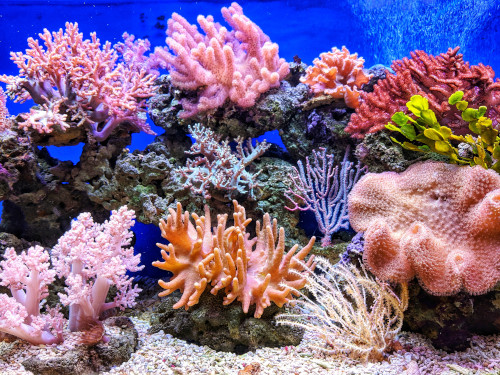
Clean water. At least natural water. And natural water flows without pollution, so clean and pure water.
In addition, ‘schools of fish’ should be kept intact as much as possible, or they should be caught together if there is no other option.
The proportions should also be closely monitored. So that young animals should be released with adult animals. Not just young animals, because then too little identity awareness is anchored in the young animal to create educational behavior again.
Young animals are now thrown overboard, but not accompanied enough by older animals that can already transfer consciousness.
DOLPHINS
What does the dolphin teach us from a spiritual point of view? Dolphins have a very well crystallized playful consciousness on the one hand, and a very strong self-knowing level on the other. And that in the combination of playfulness and self-awareness, people’s consciousness is also stretched in order to integrate both qualities into themselves.
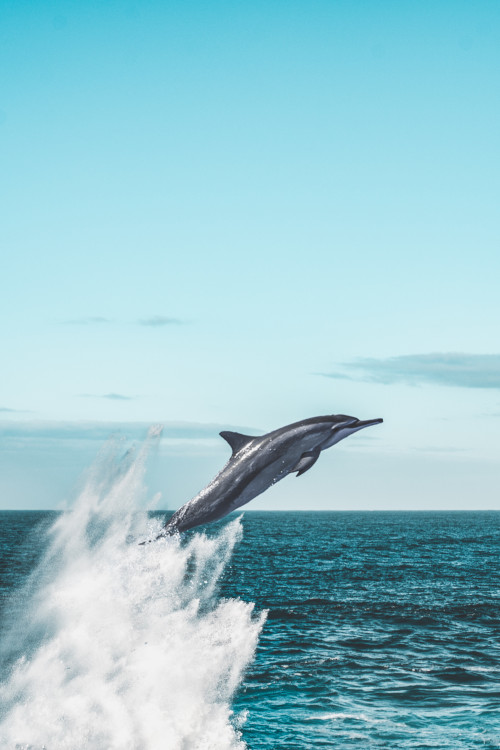
Read more about the Dolphin
Because on the one hand, people no longer dare to enjoy themselves, in view of all the suffering that takes place, an important quality of ‘being human’ is removed. Namely the theme of ‘indiscretion’, ‘casuality’, cherishing themselves completely within the natural elements, people hardly dare to surrender to them anymore.
The other aspect of the dolphin is that enormous self-knowledge, which allows them to release themselves in such a consciously structured way, purposefully for the benefit of developments outside themselves, that they profile themselves in a special way that is not yet possible for humans.
Making contact energetically (for those who feel something for it), and if only in meditation, with dolphins, makes that one’s own self-awareness becomes stronger, that one dares to act in a more focused way, without being short of playfulness.
Because you can imagine the more you know, the more responsibility you bear. And if that doesn’t have a good counterbalance in playfulness, then it becomes a tough affair. A dolphin just knows how to ‘swim’ through it‘.
But we all know the dolphins as a tourist attraction. That is almost unavoidable because people often do not wish to gain consciousness on a different level. (And dolphins also have a high cuddly factor). In principle, however, ’tuning in to’ is often sufficient for acquiring consciousness.
That used to be the case, for example, like Indians had totems. They lived so deeply with the creature’s being that they absorbed those qualities, as it were, even if they only encountered a bison or another animal once in a while. It was the inner connection that they made and we can do the same with dolphins without you having to literally treat them.
Another interesting fact, dolphins observe skeletons. So imagine if a pregnant woman is swimming in their environment, and they see that she is pregnant. And they love pregnant women. Too!
Have you seen the Declaration already?
A Charter on the Importance of Animal Rights
